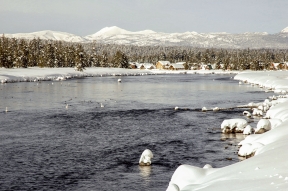
The temperature this morning read -7° F when I walked into my office in St Anthony. I called Chris and Todd at the shop in Island Park and they reported the low was around -20° F. It was still off the record of -35° F set in 1972 but still – Very Cold! As I look through the cottonwoods, across the snow fields, at the slush ice flowing down the Henry’s Fork I can’t help but marvel at how fast the season has changed. As the late Andy Rooney once said, “Life is like a roll of toilet paper. The closer you get the end the faster it goes.”
It’s not the end of the calendar year but for me, my fishing year is over. There are always a few nut cases who are willing to brave frost bitten fingers and iced up guides. There was a day when I was one of them. Today, comfort has moved higher up my list of what’s important in my fishing. It’s time to break out my fly tying stuff and start planning for the upcoming season. It’s also time to reflect. The 2018 season was very good to me. Here’s a brief rundown of the most prolific waters in our region.
Henry's Fork
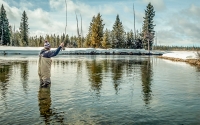
In January and February the upper river from Big Springs on down to Riverside Campground, with the exception of the Ranch, produced great dry fly fishing with midges and nymph fishing if you could get to the river. Todd Lanning tried in vain to get me to come up and fish the Last Chance area but I wasn’t willing to hike through 4 feet of snow even for a short distance. The fishing got even better as the weather warmed later in February and March but the snow got deeper.
By mid-February things started happening on the lower river. Dry fly fishing with midges was the name of the game with the slow backwaters like Chester and the Fun Farm. Midge fishing was also good in the soft margins from Warm River downstream.
We started getting our first mayflies, size 18 Blue Winged Olives, by the end of March. It’s always exciting to see these beautiful little mayflies. Trout always get excited as well. By mid-April there were good numbers of larger March Browns showing on the lower Henry’s Fork. Soon after that our first caddisflies, the famous Mother’s Day Caddis made their appearance. While the BWOs and March Browns could be rated about average, this year’s Mother’s Day Caddis was epic. Some of the best dry fly fishing of the entire year occurred from Ora Bridge downstream to St Anthony when these size 16 caddisflies were emerging. Sadly this great fishing came to an abrupt halt about the 7th of April when Fall River ramped up with snow runoff. High water from runoff didn’t impact the Henry’s Fork between Ashton and Fall River until after the 20th of the month.
The runoff on the lower river above Fall River came to a peak at the end of April. From my perspective I would prefer to see the snow stay in the mountains longer. Ideally I’d like the peak runoff to hold off until at least the middle of May. This scenario provides a much longer period to fish the early season mayfly and caddisfly hatches but also allows for a productive salmonfly hatch.
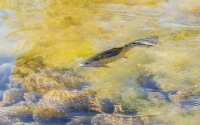
As it was, our salmonfly hatch started up about the middle of May and moved up the river in leaps and bounds. By the end of May we had salmonflies all the way upstream to Riverside Campground and into the Box Canyon. This isn’t to say we didn’t have a great salmonfly hatch. There were lots of huge trout caught on dry flies but the salmonfly hatch was short lived.
Fishing remained relatively quiet on the upper river until late May. There were some nice fish feeding on BWOs and March Browns at Last Chance but the fishing was far from spectacular. Most anglers I talked with were disappointed in the Ranch opener on June 15th. As always I heard some great reports but on average most anglers felt the number of feeding fish was down and the hatches didn’t live up to expectations. As I have stated in the past, I personally do not fish the Ranch until after the middle of July. There are two reasons for this. First off, for the first month after the opener the river is crowded with other anglers. Many if not most of them are our customers. They don’t need guys like me who have all summer to fish competing with them. The other reason relates to the first. Heavy fishing pressure has an impact on the trout. More of them are caught, some of them die from being caught and released, and I believe that all of the traffic impacts their behavior. I’m more comfortable fishing after the middle of July when there aren’t nearly as many anglers and the trout normalize their feeding patterns.
Another reason I don’t fish the Ranch in June and early July is because the Lower Henry’s Fork is awesome. There were Pale Morning Duns and caddis bringing large trout to the surface on a daily basis. However the hatch of the year on the lower river was the Gray Drake hatch. Not since 2011 have we seen such an epic emergence of Gray Drakes. I have an intimate knowledge of the ¾ mile stretch of the Henry’s Fork that runs through our property just upstream from St Anthony. Sometimes I feel like I know every fish in this part of the river. Yet when these hefty size 10 mayflies covered the water I saw dozens of large trout feeding in places I never knew existed. Along with the Gray Drakes, Green Drakes, Flavs and Golden Stoneflies brought forth the best dry fly fishing in the region. Sadly, by the first of July it was over and everything came back to normal.
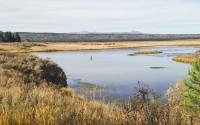
I didn’t venture into the Ranch until the crowds dissipated in late July. By that time there wasn’t a strong concentration of aquatic insects but when there were bugs on the water, the trout came up. This was especially true with the PMD spinner fishing in the evening hours. I concentrated my fishing in the flat water above the middle bridge in August, one of my favorite periods so fish this water. There were enough PMDs, Callibaetis, Tricos and terrestrials to keep things interesting. Mahogany Duns showed up right on schedule early in September. Along with small BWOs, these size 18 mayflies kept the dry fly fishing at par. As always happens, dry fly fishing actually improved in October and well into November.
To sum things up, overall the fishing on the Ranch was good but not great. I base my opinion on the success of our guide trips, chatter in the fly shop, some of the Ranch regulars that I trust, and my own experience. June was especially disappointing but things picked up as the season progressed. Our guide clients caught some very large rainbows on hoppers. It wasn’t all blind fishing. Personally I spotted a number very large trout New Zealand style, holding in the current, not feeding on the surface. In most cases when I made a good cast with a good drift over the trout, it was on. The most positive thing I have to share about the Ranch is the number of small to medium sized trout I saw. In my mind this section of the river is very healthy. We had a good flush early in the season. This caused a bit of an uproar with the angling community but it moved a lot of sediment that had accumulated over the years. I saw more clean gravel. I’m excited for this season with the prospect of optimum winter flows.
I can’t move on without a note about a couple of other sections of the river. As usual the Box Canyon fished well throughout the season. Good dry fly action for larger fish when the big flies were around in June and early July. Otherwise the nymph game was on producing lots of smaller fish mixed up with some larger ones throughout the season. I felt the float from Warm River to Ashton was much better than usual. We utilize this stretch a lot with our guide clients. I took a couple of donated trips myself. We caught lots of smaller to medium sized rainbows along with some very nice browns. Year after year this is one of the most consistent stretches of the Henry’s Fork.
Madison River
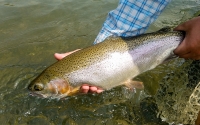
The Madison is a very good option during the winter months. Open year round, you can catch nice fish every month of the year. Todd Lanning reported some great days in January and February. We also have a number of friends and customers who come specifically to fish during the winter months. Once the runoff subsided in late June the Madison was awesome. Now that work on the Hebgen Dam has been completed we expect this trend to continue.
The salmonfly hatch moved up the river rapidly from the Ennis area about the middle of June to Reynolds Pass by the 4th of July. Most anglers who were willing to brave the crowds caught some nice fish. Some of the best fishing occurred after the salmonfly hatch. Good hatches of PMDs and evening caddis continued throughout July. Terrestrial fishing picked up in August and continued well into September. Fall fishing was very productive with nymphs and streams. All in all we felt it was a great year on the Madison.
South Fork of the Snake
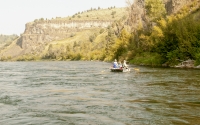
This large tailwater provides a great option for fishing during the winter months. While flows maxed out well over 24,000 cfs during the runoff it remained steady at around 2500 cfs during February and most of March. This provided great opportunity for dry fly fishing with midges. Nymph and streamer fishing also produced some very nice trout.
Fishing on the South Fork has everything to do with stream flow. The runoff ticked to almost 20,000 cfs up by mid-March making fishing difficult. Hard core anglers still caught fish with nymphs, streamers and San Juan Worms. The flow stayed high throughout May and June but came into favorable conditions by the 1stpart of July just in time for the salmonfly hatch. Like the Madison, the river gets very crowded during this period
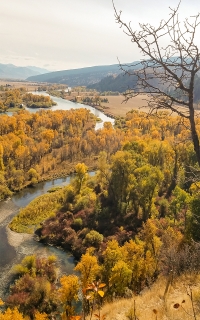
My favorite way to fish this river is to work the shallow water and riffles when the mayfly hatches are on. In my opinion I didn’t think this was a great year for this type of fishing. The heavy runoff during June really moved some stuff around. There were riffles and gravel bars where there had been none before and visa-versa. It has been my experience that when gravel bars and riffle get moved around it doesn’t help the hatches of aquatic insects. When you could find the few stable areas stable areas that weren’t affected by the heavy flows you could find feeding trout.
This isn’t to say that the South Fork didn’t fish well. Fishing was very good using the dry/dropper technique throughout the season. There were lots of nice trout and in very good condition. Some of the best fishing occurred in the autumn. Streamer fishing produced some very large trout. My brother Rick and I, along with our good friend Barry Austin from Texas, floated a section of the river during the second week of July. Our intention was to use streamers. Fortunately we also brought our #4 weight rods because we found blanket hatches of BWOs throughout the day. We caught so many nice trout on dry flies that we didn’t even make a cast with a streamer.
Teton River
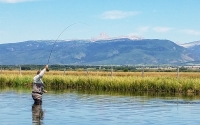
Over the past few years I’ve made no secret that this river is very dear to me. I grew up on it. Like our other local rivers, it fishes well during the winter months. The upper section near Driggs is a true spring creek even though it gets flooded with runoff from the Teton Range in May and June. The average flow during the winter months is about 250 cfs.
By the first part of May the river was very high making fishing pretty much impossible. It stayed high almost to the middle of July. From then on the fishing was fantastic. Pale Morning Duns hatched on a daily basis until early September. Smaller Blue Winged Olives, caddisflies, yellow sally stoneflies, and golden stones completed the menu.
One of the greatest challenges of fishing the Upper Teton is the amount of recreational floating. During the peak summer months it gets covered up with paddle boards, canoes, kayaks, tubes and almost anything else that will float. We even saw a couple of very hefty folks floating on an inflatable couch. When the hatches are on the trout usually start rising again shortly after the floaters pass through. If they didn’t they would never get anything to eat. The largest trout usually find hides away from the main flow near the brush on the banks and in the deeper water. You can sometimes minimize the floating traffic and noise by floating other sections than the South Bates down to the Rainy access. Another option is to wait until late in the day as some of the best hatches occur in the evening hours. Most of the float sections are short. I had some great evenings leaving home in St Anthony about 4 pm and fishing until dark.
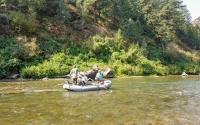
The Teton Canyon provides a unique opportunity to some unspoiled trout water along with a good adrenaline rush in the process. This trip isn’t for the faint of heart as the guides must drag rafts down a steep 1500 rock canyon face to the river below. Once in the river you must negotiate a half dozen whitewater rapids. You must be very experienced rowing whitewater if you want to do this trip yourself. Otherwise, you need to hire a guide. This past summer many of our clients opted for this trip and they weren’t disappointed. Unfortunately, the streamflow dropped in September so that we were no longer able to do this trip.
Even though I can still row a drift boat without difficulty, Sheralee and I try to take at least one trip a year with one of our guides so we can both fish together. This August we joined friends Robert and Kelli Dotson with guides Colton Schofield and Matt Murphy to float the canyon. It was a great trip with constant action catching cutthroat trout on big dry flies. Even though there are some very deep, wicked looking pools I have not caught many large trout over 20 inches on this part of the river. That held true on this trip as most of our fish were in the 12 – 16 inch range. However, while the guides were getting the boats in I walked upstream and cast a foam hopper into a deep, fast slot. The line went tight and I was quickly attached to a huge trout that went racing upstream through the fast water. I tried to follow but it was impossible. I couldn’t do anything with this fish before he wrapped me around a big rock 30 yards above where I hooked him.
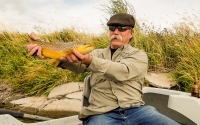
The Lower Teton River has provided quality fishing for our guide clients since were first acquired a legal permit to guide there four years ago. Access to the lower river is only 6 miles from my house. Fishing is good in the evenings providing a great opportunity for me to finish out my day casting to big rising trout. Our only complaint was that this section of the Teton remained very high until the middle of July. Some of the best hatches including Green Drakes, Gray Drakes and Pale Morning Duns come off in late June and early July. We missed some of the best dry fly fishing because of high water yet we had good fishing throughout the remainder of the season.
In mid-October I fished the lower water with good friend and former Henry’s Fork Anglers’ guide A J Campbell. The fishing was pretty tough. We tried nymphs and streamers but only landed a few fish. One of the main attractions here is the potential to hook a really big trout. As we neared the end of the day I decided to scale down to 5X with a double nymph rig. The top fly was a #16 Two-Bit Hooker and the bottom a #18 Pheasant Tail Beadhead. I tightened when the indicator moved and the water exploded. My best view of the trout was his tail that looked 5 or 6 inches wide. The trout blew up again on his way downstream. I chased him down about 50 yards until he finally gave in and I was able to steer him to A J who was waiting with the net. I knew he’d make a hard final run when he saw the net and he did just that. The problem was I had a heavy jacket and the reel handle touched my elbow and it was over. At least I got to get a good fight out of him and see him. A J had a good close look. He was a big hybrid, a good fish to end my season. After that I put my fly rod away and started hunting whitetails with my bow.
Lakes
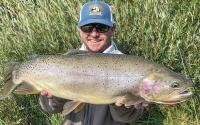
We heard lots of complaints about the fishing in Henry’s Lake throughout the season. In fact we didn’t hear a positive report until the middle part of August. After that everything changed. Several of our guides started fishing the lake and their clients caught some lunkers. In fact I can’t ever remember as many truly large double digit trout caught in the 42 years we’ve been in business. Hebgen Lake produced great dry fly fishing throughout the season. All in all, for those who like to fly fish lakes, there was some very fine fishing to be had.
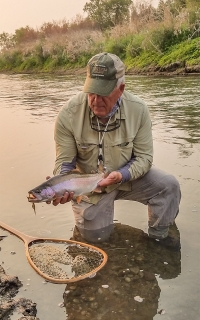
I’ve been writing up these end of season reports for many years. Virtually all of them have been great seasons. How could they not be? When we have rivers like the Henry’s Fork, Madison, South Fork and Teton, not to mention our great lake fishing, you can’t go wrong.
It’s early to know what to expect for the coming year. The biggest part of the story is winter flows. On the Henry’s Fork good winter flow translates into good fishing. This year will be the second winter in a row with optimum flows from the Island Park Dam. Couple that with well above average storage in our reservoirs and we should expect another great year. Look for my 2019 season outlook in March.
Until then, we wish all of our customers, friends and employees the very best of the holiday season and most of all, we sincerely thank you for your support.